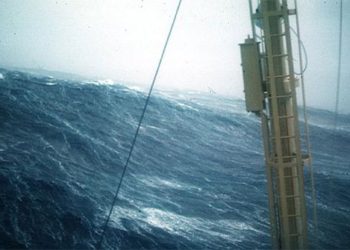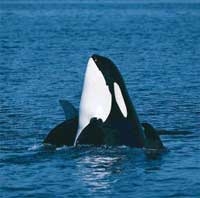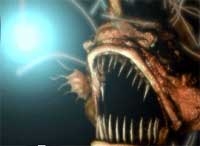Charles Darwin believed that evolution created “the most beautiful infinite forms.” However, his theory of evolution and its implications do not explain why nature continues to produce crabs.
Scientists have long wondered if there are limits to what evolution can achieve or if Darwin’s ideas were entirely accurate. The truth may lie somewhere between these two points.
While it appears that there is no limit to the number of species that can evolve, there may be restrictions on the number of basic forms that a species can evolve into. The evolution of crab-like creatures may be one of the most striking examples of this, as it has occurred not just once, but at least five times.

Crabs are a typical example of defying evolutionary theory.
If you didn’t know, crabs belong to a group of crustaceans called decapods. This term literally means “ten-footed,” as they have five pairs of legs for walking. Some decapod species, such as lobsters and shrimp, have thick and muscular abdomens. With a quick flick of their tails, lobsters can propel themselves backward to escape predators.
In contrast, crabs have compressed abdomens tucked beneath their broad, flat carapaces. This allows them to hide in rock crevices for protection. Evolution suggests that this solution is the most feasible.
Five Groups of “Crabs”
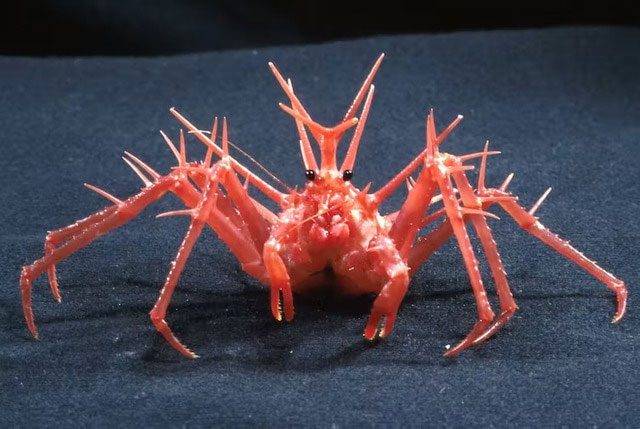
King crabs evolved from lobster-like ancestors in Anomura.
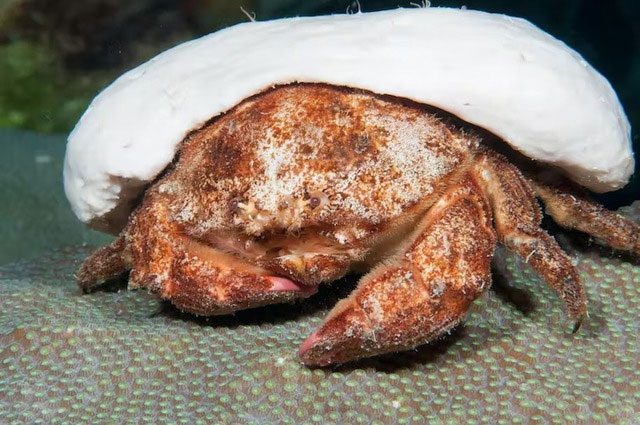
Red-eyed sponge crabs like to carry a piece of sponge for camouflage.
Now, let’s get acquainted with a new concept. “Crab” is not actually a true biological group. They are a collection of branches on a decapod tree that have evolved to resemble one another.
The largest crab group is Brachyura (true crabs), which includes edible crabs and Atlantic blue crabs. They have ancestors that also resembled crabs. Some species have evolved “backward,” extending their abdomens again.
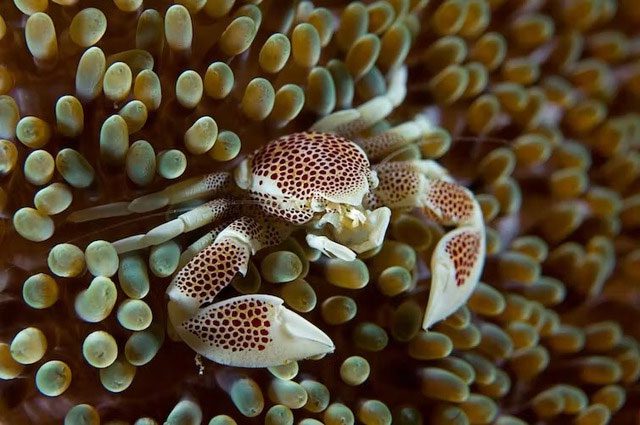
Porcelain crabs closely resemble true crabs.
Another large group is called Anomura (or false crabs), whose ancestors looked more like lobsters.
However, at least four groups within Anomura, including sponge crabs, porcelain crabs, king crabs, and Australian rock crabs, have evolved independently but have taken on a crab-like form in a manner similar to true crabs.
Like true crabs, their compact bodies offer greater defense and allow them to move sideways more quickly.
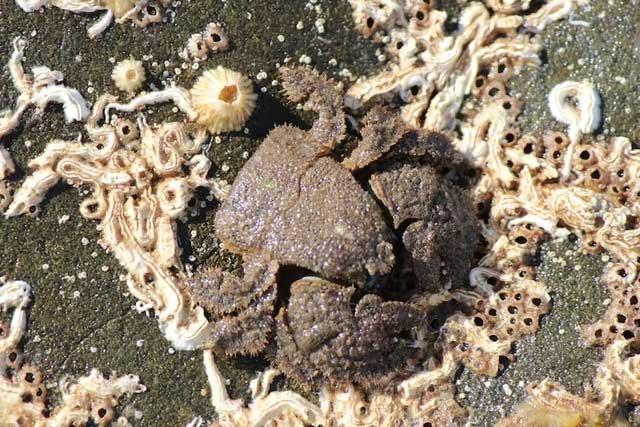
Hairy rock crabs (Lomis hirta) are also crab-like crustaceans.
Crabs Are Not the Only Exception
A similar phenomenon occurred in the evolution of birds, which evolved from feathered dinosaurs. Feathers may have first evolved for insulation, to attract mates, to protect eggs, and possibly to form “nets” to catch prey. Millions of years later, feathers became longer and more streamlined to facilitate flight.
Paleontologists may disagree on the details, but all modern birds (the Neoaves clade) evolved from ground-dwelling ancestors just after the mass extinction event that wiped out the dinosaurs.

Microraptor had up to two pairs of wings.
However, feathered wings and the ability to fly also evolved earlier in other dinosaur groups, including Troodontidae and Dromaeosaur. Some of these, like Microraptor, had up to four wings.
Rewinding the Tape of Life
Unfortunately, we cannot conduct evolutionary experiments to see if similar processes continue to occur. Because that would take hundreds of millions of years. But the history of life has done something similar for us, as closely related lineages have evolved and diversified on different continents. In many cases, these ancestral lineages have repeatedly produced similar or nearly identical evolutionary solutions to problems.
One of the best examples is the group of mammals.
There are two main groups of mammals: placental mammals (including humans) and marsupials (mammals that give birth to small young). Both groups evolved from a common ancestor over 100 million years ago, with marsupials primarily in Australasia and the Americas and placental mammals elsewhere.

The skull of the Tasmanian wolf or thylacine (left) and the gray wolf, a placental mammal (right), shows striking morphological convergence, despite evolving separately on different continents.
This isolation has led to two instances where nature has run a “test” almost independently to see what it can do with the mammalian body plan. The results produced pouch and placental versions of moles, mice, anteaters, flying squirrels, and cats. There was even a thylacine (Tasmanian wolf, extinct in 1936) that had a skull and teeth fit together in astonishing detail.
Not only have body forms evolved independently, but so too have other organs and structures. Humans have eyes designed like a complex camera with a lens, iris, and retina. Cuttlefish and octopuses, which are mollusks and more closely related to snails and clams, have also evolved eyes with similar components.
Overall, eyes may have evolved independently up to 40 times in different animal groups. Even box jellyfish, which lack brains, have eyes with lenses at the base of their four tentacles.
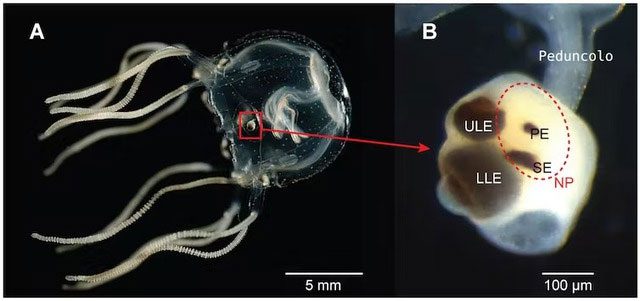
The eyes of box jellyfish. These invertebrates near the base of the animal evolutionary tree have complex eyes.
The more we observe nature, the more we see similar cases. Structures like jaws, teeth, ears, fins, legs, and wings continue to develop independently on the animal tree of life.
More recently, scientists have discovered that convergence also occurs at the molecular level. Opsin molecules in the eyes convert photons of light into chemical energy, allowing humans to see. And they closely resemble the molecules in the eyes of box jellyfish. Strangely, different animals like whales and bats show remarkable convergence in the genes that allow them to echolocate.
Are Humans Truly Unique?
Many things that we want to think make humans special have actually been reinvented by evolutionary processes in other species. Some species of crows possess the intelligence to solve various problems and, along with owls, can use simple tools.
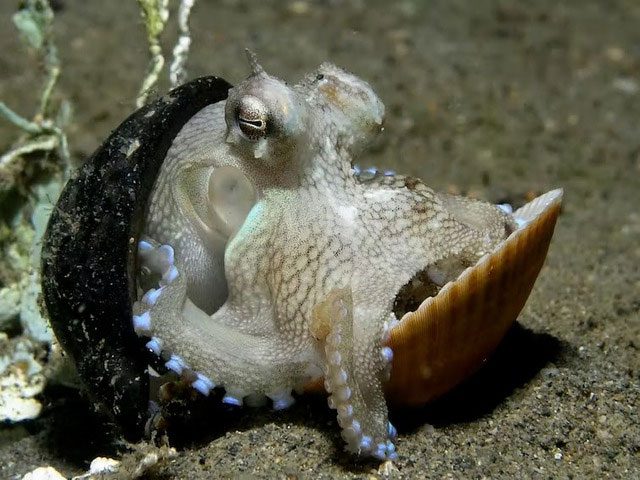
Veined octopus (Amphioctopus marginatus) knows how to use everything around it for camouflage.
Whales and dolphins have complex social structures, and their large brains allow them to develop language. Dolphins use tools like sponges to cover their noses when foraging in rocky seabeds. Octopuses also use tools and know how to learn by watching what happens to other octopuses.
If things continue to evolve in similar ways here on Earth, it is likely that they will follow a related process if life has developed elsewhere in the universe. This could mean that extraterrestrial beings might look less alien and more familiar than we expect.








































